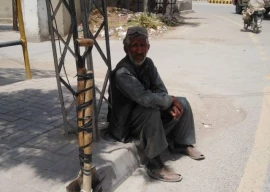
The president visited Sukkur and was briefed about the damage and relief efforts in the densely populated southern province of Sindh, where the government said on Thursday that waters were receding.
PTV broadcasted silent footage of Zardari, wearing a traditional Sindhi cap and patting the head of an elderly woman at a relief camp, before visiting Sukkur Barrage and viewing the water.
Local officials told a news agency that the president distributed relief goods among flood victims at a camp in a college, assuring survivors that the government was doing the maximum possible to assist them.
The government has admitted to being overwhelmed, while Islamic charities have conducted a highly visible aid effort on the ground.
Writing in The Wall Street Journal on Wednesday, Zardari defended his decision not to cut short his overseas tour, saying he had used his talks in London and Paris to drum up desperately needed foreign aid for the tragedy.
The main opposition party, Pakistan Muslim League-Nawaz (PML-N), criticised his visit to Sindh as too little too late. “He is president of Pakistan and he should behave like a president,” said spokesman Siddiqul Farooq.
Analysts warn Zaradri’s image will only improve if the government can bring the flood crisis under control and rapidly improve the relief operation.
The UN has appealed for $460 million in foreign aid and says billions will be needed in the long term, with survivors facing grim conditions in makeshift tent cities and diseases flourishing under unbearable heat.
The UN humanitarian coordinator in Pakistan, Martin Mogwanja, said pledges of $195 million had already been made. UN official Ban Al-Dhayi warned of water-borne diseases and illness such as diarrhoea, malaria and dengue fever.
“There are concerns about potential outbreak of vaccine-preventable diseases like measles, polio, tetanus, and also respiratory infections are huge threats as well, especially between children,” he told a news conference.
At one camp in Nowshehra, in the northwest, three-month-old Aisha lay on the floor, screeching in the morning heat, which was laced with the stench of raw sewage and buzzing with mosquitoes.
“She cries the whole night. I don’t know what illness she has, but the doctors told me she will be alright,” said mother Shakila.
The US sent two Marine helicopters to Pakistan from an amphibious assault ship, the first of 19 to be made available in coming days.
World Food Programme official Wolfgang Herbinger said the UN had enough food to cater for more than two million in the next 10 days, but that bad weather and limited access was a problem.
In the south, a mass exodus of people was putting an extra burden on local economies and infrastructure, said Sindh government spokesman Jameel Soomro.
“We have a plan to shift flood victims to tent cities... More than 100,000 people have arrived in Sukkur from different flood-hit areas, which is more than five per cent of the city’s population,” he said.
Talking to The Express Tribune, flood victim Amnat Ogahi said that the moment the floods came into their village was like “doomsday for us”. She added that she fled the village with her children, is still unaware of the whereabouts of her husband.
Mother of two, Mureedan complained that the government is doing nothing for them, unlike the local people who provided food, water and medicines to the flood survivors.
In Punjab, one of the worst affected areas was the town of Muzaffargarh, where administrator Farasat Iqbal said up to 400,000 people had been evacuated and rising waters posed a risk of flooding the town in the next 24 to 36 hours.
However, Chief meteorologist Arif Mehmood, told a news channel that water levels were going down in parts of Sindh, Punjab and the northwest.
(Additional reporting by Sarfaraz Memom in Sukkur)
Published in The Express Tribune, August 13th, 2010.

















COMMENTS (5)
Comments are moderated and generally will be posted if they are on-topic and not abusive.
For more information, please see our Comments FAQ